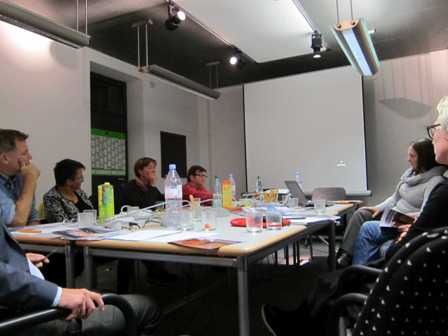A Technical Discussion about “Conflict Resolution in Practice”
 In principle, the German opposition party “Die Linke” objects to military operations in foreign policy. However, the question of how to respond to civil war remains to be answered. Recently, it has been found that many projects have shown what could be possible if German foreign policy prioritized more than just military solutions as a response to crises and conflicts worldwide. Kathrin Vogler and Jan van Aden (‘Die Linke’ Parliamentarians), invited Brigitte Hinteregger and Stephanie Buljugic, two civil conflict resolution practitioners, for a discussion of this issue. “When talking about Civil Conflict Resolution the term often stays unwieldy and unclear,” said Kathrin Vogler. “In reality this work is very fascinating, challenging and, even if this is not well known, very successful.”
In principle, the German opposition party “Die Linke” objects to military operations in foreign policy. However, the question of how to respond to civil war remains to be answered. Recently, it has been found that many projects have shown what could be possible if German foreign policy prioritized more than just military solutions as a response to crises and conflicts worldwide. Kathrin Vogler and Jan van Aden (‘Die Linke’ Parliamentarians), invited Brigitte Hinteregger and Stephanie Buljugic, two civil conflict resolution practitioners, for a discussion of this issue. “When talking about Civil Conflict Resolution the term often stays unwieldy and unclear,” said Kathrin Vogler. “In reality this work is very fascinating, challenging and, even if this is not well known, very successful.”
Brigitte Hinteregger, a trainer for Conflict and Crisis Management, shared her experience about her work in traumain civil conflict resolution projects in Liberia and South Sudan. In Liberia, for example, approximately 250,000 of its four million citizens lost their lives during the 14 years of civil war.
(Published Dec. 9, 2015)
Hinteregger believes the trauma caused by civil wars not only affects the individual, but is a multi-layered social phenomenon affecting the society as a whole as well, with all levels being interconnected. Additionally, the victims of rape or other horrific experiences often suffer from social stigmas and marginalization. She worked for several years to counter this social exclusion by offering training for members of the local community on the structural root causes of violence. The courses were made to empower and build the capacity of people to continue this kind of work in their own communities as trauma workers and counselors.
Hinteregger emphasized that these are long-term goals, and success will only be seen after several years. It is necessary to start these projects, not just as pilots, but with a long-term, comprehensive plan that will meet the needs of the community. Unfortunately the funding of projects like these is often limited to one or a few years at most.
While trauma-work following violent conflict is often considered to create the basis for prevention of further outbreaks of violence, Nonviolent Peaceforce’s (NP) work takes place within existing conflicts. The second guest, Stephanie Buljugic, was actively working for the International Non-Governmental Organization (INGO) for several years in Sri Lanka and South Sudan. NP is convinced that the most effective way of protecting civilians is through a method called “Unarmed Civilian Protection,” or UCP. This involves the direct protection of civilians from physical harm as well as the support and empowerment of the local society. NP further works on building and strengthening the capacity of existing protection mechanisms and local peace networks.
Approximately 150 people are currently working for NP in South Sudan alone: nationally, internationally, and at the grass-roots level. They have been successful even with the escalating civil war due to the fact that their teams are directly embedded in the local communities, using nonviolent strategies for their clients’ and their own protection. From saving civilians from massacres and accompanying them to safe zones, to nonviolently solving local conflicts between cattle-clans, to forming “Womens’ Peacekeeping Teams” to counter gender-based violence and underage marriage, the organization has had successes on many levels.
Even within ‘Die Linke,’civil peace service does not receive the attention it deserves. “I hope this event contributes to a change,” said Kathrin Vogler, who also represents the left opposition party in the subcommittee for Civil Crisis Prevention.
By: Marek Voigt, translated from German into English by Stephanie Buljugic
